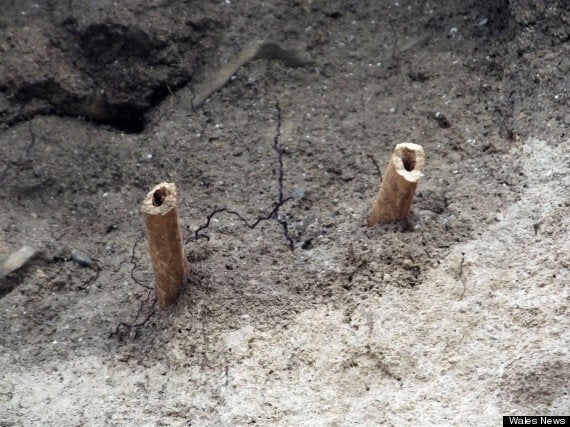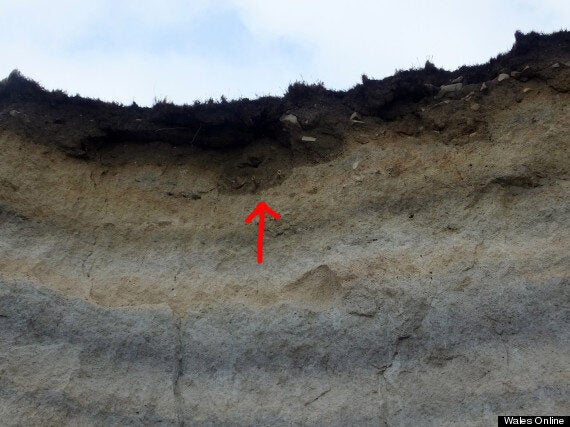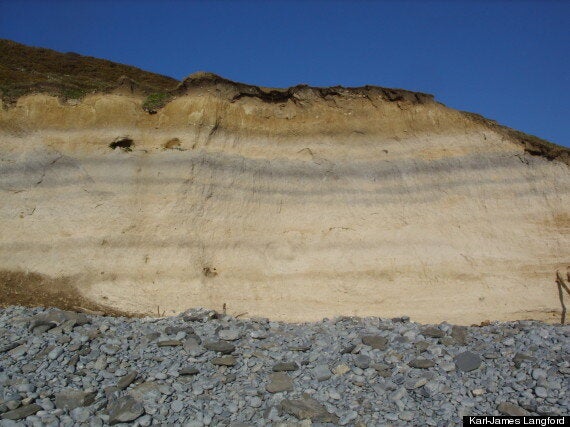A beach walker has discovered the 800-year-old remains of a monk - after she spotted his leg bones sticking out the side of a cliff.
Rambler Mandy Ewington was strolling along the sea shore of Monknash, South Wales, when she looked up and saw two bones poking out of the cliff face.
She took a picture and sent it to leading coastal archaeologist Karl-James Langford.

The femurs were spotted sticking out of a cliff face in Monknash, South Wales
Langford, 39, told Wales Online: "I thought she must have been mistaken but I went down to see for myself and thought: 'Bloody hell, this is amazing!'
"You can clearly see a grave has been eroded into the sea. What is fascinating is you can see the two femurs being slowly revealed as the cliffs are eroded away."
University lecturer Langford said the area used to be a burial ground for Cistercian monks in the Middle Ages.
He said: "There was a monastic community close to the area and these bones indicate a male in their late 20s who was in good health.

The bones are believed to have belonged to a man in his late 20s
"I would say they belong to a monk from the 1200s - due to previous archaeological digs in the past, the depth of the bones in the cliff and the history of the area.
"He would likely be buried with nothing except two shroud rings which would have held his burial shroud in place at the head and feet. It's quite an easy picture to put together.
"The valley is named after the Welsh saint Cewydd and was home to a community of Cistercian Monks from 1129 until the dissolution of the monasteries 1535."
Langford, who runs Archaeology Cymru, said the winter storms had caused huge swathes of the British coastline to collapse and precious archaeological sites were being revealed and lost to the sea.

It will be impossible to excavate the bones because they are in such a dangerous position
He added: "It's like watching archaeology going like the pages of a book and the history is being revealed with every turn of the page.
"But unfortunately nobody can touch or excavate these bones because they are in such a dangerous position."
Speaking from the site itself, Langford told HuffPost UK: "They are being given their last rites rather than being mucked around with by archaeologists.
"We can't save everything. This beautiful find really tells us the tragedy of human life - the memento mori movement where life has to come to an end. The belief that Mother Earth would take you and absorb you back into the soil.
"Even though it is a tragedy, it also plays into the concept of regeneration. Our ancestors have come full circle by being washed into the sea."
Human bones were discovered in the area in 1982, when a long-bone was found, and then in 1990 part of a skull was picked up. Three years later, excavations revealed three adults buried in an east-west line.

The erosion of the cliff face has been exacerbated by recent storms
The Cwm Nash Burial Ground is listed by the Royal Commission on the Ancient and Historical Monuments of Wales as an "unofficial burial ground used by parishioners of Monknash".
A 2012 report by the Glamorgan Gwent Archaeological Trust concluded that the burials found on cliffs at Cwm Nash probably date from some time in the post-medieval period (1485-1901).
Langford said the recent winter storms had caused massive coastal erosion around the British coastline and archaeologists couldn't keep speed with the number of sites being lost to the sea.
He said: "In just a couple of weeks of storms we lost a foot of our coastline. If you put that into perspective - over the last 2,000 years we have lost about 1km of the coast line.
"Erosion is accelerating so fast we can do nothing about it. We are losing burial grounds, hill forts and whole settlements all washed into the sea.
"But archaeologists cannot do the work on these sites and excavate them because they are so dangerous - they are on the edge of a sea cliff.
"I take my students to Orkney every year and we are being told by the archaeologists up there that they are losing sites so fast they cannot excavate and document them quick enough.
"On the east coast around Norfolk the erosion has been going since time immemorial and now we are getting erosion on the west coast.
"There are hill forts along South Wales which will not exist in 10 years time as the cliffs will be completely gone."